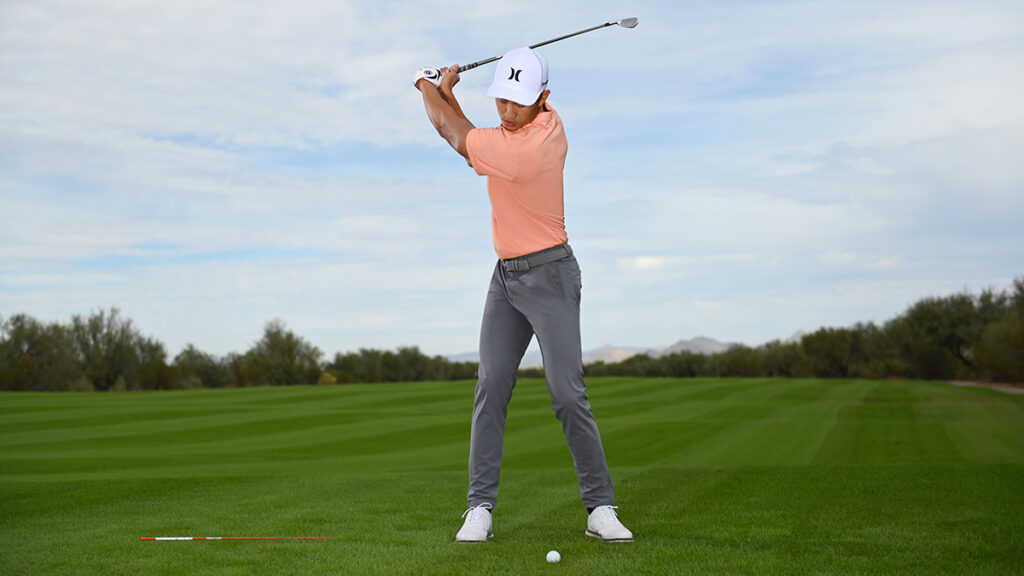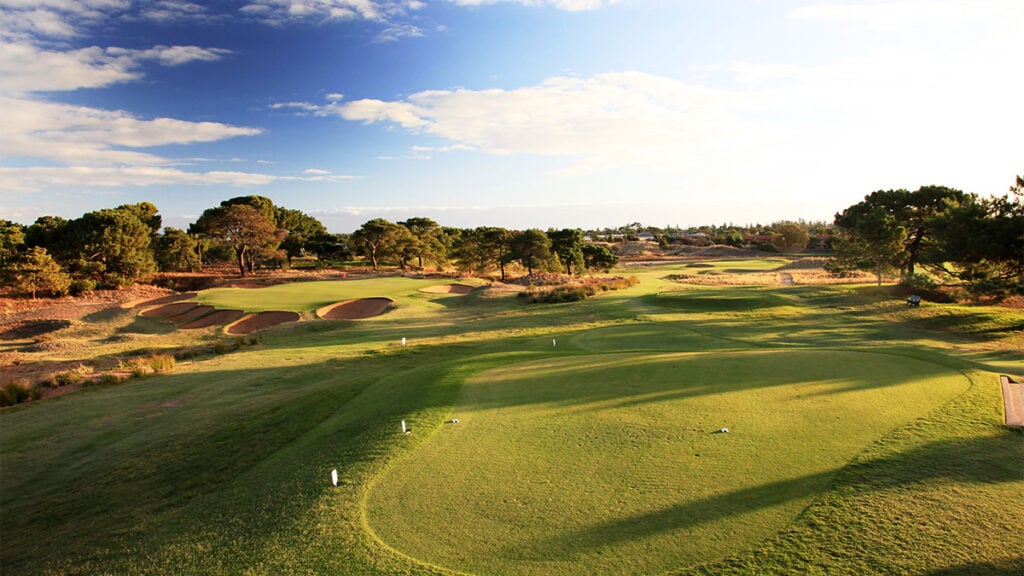Seven tips from seven PGA professionals who want to put some youth back in your game
Our motto here at Golf Digest is “Think Young, Play Hard”. It’s a nod to doing whatever we can to play like we did in our youth despite advancing years.
Why chase golf’s uncatchable fountain of youth? There’s a carefreeness to young golfers that makes older golfers jealous, reminisce – or both. Equally, there are new perspectives that younger PGA professionals can provide on the instruction front. With that in mind, here are seven tips from seven golf coaches younger than 40.
What makes this group of instructors stand out? Most notably their passion for making regular golfers better, but there’s a lot more to it than just a love of the game. These teachers are equally adept at giving lessons using 3-D imagery as they are with an alignment rod and an impact bag. Here, we’ll give you a taste of their abilities as they share quality practice tips on hitting every shot solid.
Keep your chest up in a fairway bunker
By C.J. Nafus, Roxiticus Golf Club, Mendham, New Jersey
Hitting it solid out of a fairway bunker is one of the most challenging shots for regular golfers. There is a tendency to put some ‘body english’ into the swing, and that often results in poor contact. Let me help you make these shots a little easier.
The first step is to make sure you chose a club with enough loft to clear the lip. I hope that’s obvious. And whatever club you choose, grip down a little to compensate for having your feet lower when you dig into the sand. You’ll want to firm up your footing to avoid slipping or spinning out on the unstable surface.
At setup, you also can ensure crisp contact by standing a little further from the ball than normal and keeping your chest up – those two adjustments are very important. Your ball position can remain normal depending on the club you choose.
Now let’s talk about the swing. Think about maintaining the height you started with at address. Remember when I said to keep your chest up [Featured image]? If you lower it during the downswing or rise out of that tall posture, you’ll probably mis-hit the ball. The goal is to pick it clean out of the sand. Even if you thin it a little, that’s probably going to work out. To further help with that, keep your lower body ‘quiet’ through the strike.
Last tip: don’t let your swing arc drop below the level of the sand.

‘Let go’ on those tricky half-wedge shots
By Ashley Malaska Moss, Malaska Golf, Queen Creek, Arizona
With wedge shots, distance control is the top priority. To ensure you have your yardage dialled in, you need to consistently hit the ball solid in the centre of the clubface. A saying I use with my students is, “To gain more control, you have to let go of control.” Let me explain what that means.
With these half-swing wedges, I see too much tension in the hands, arms and bodies of many golfers at address and during the swing. Why? They try too hard to control every aspect of the shot, literally steering the ball to its target. That only leads to all kinds of mis-hits and undesirable outcomes.
Next time you have a less-than-full wedge distance into a green, focus on having lighter grip pressure. You want to hold on soft enough so you can feel the weight of the clubhead throughout the swing. Take a few practice swings and play around with different grip pressures until you become really aware of the clubhead’s weight and movement. If you grip too hard, it will be difficult to feel anything but your hands, and you won’t swing freely.
Your goal here is to let the club do the work. When you maintain loose grip pressure, it improves your swing tempo and lets you make centre-face contact with the ball before the club hits the turf [above]. That’s how you hit it pin-high from these tricky half-wedge distances.

To compress your irons, keep your right arm high
By Jarut Padung, McCormick Ranch Golf Club, Scottsdale, Arizona
A lot of the amateurs I teach come to me with a similar fault in their backswing that makes it really hard to hit quality iron shots off the turf. The problem is that their shoulder turn is too flat as they take the club back. They keep their right arm bent and tucked into the body. This leads to a lack of inclination in the rib cage, which is a fancy way of saying the right side of the torso is not moving up as it moves away from the target.
The fix is to take the club back keeping your trail arm (right arm for right-handers) above the lead arm [above]. This will assist in rotating back on an inclined axis instead of that flat shoulder turn. You’ll be set for more of a downward strike, making it easier to compress the ball off the grass. As a bonus, it increases the width of your swing, another power key.
So think, right arm over the left as you go back.

Let your arms fall as you start down
By Kyle Morris, The Golf Room, Dublin, Ohio
To hit it solid and far with the driver, you want to shift into your lead side as you transition from the backswing to the downswing, and then catch the ball as the club is ascending through the impact zone.
It sounds simple, but this notion of getting to your lead side poses a problem for amateurs. In trying to do that, they often spin out with their body, causing a steep, out-to-in swing path that drains all their power.
To prevent this, I’ll often train students on this weight-shift board [above], which helps them make a better downswing. The key is shifting into the lead foot while allowing the arms to fall, which
helps the club get onto the correct plane for an upward strike. This move – shifting into the lead foot and simply dropping the arms – is the first step when you change direction. From there, you can push off the lead foot and pivot around it to square the clubface.

Put your speed on the target side of the ball
By Jason Sedan, Old Marsh Golf Club, Palm Beach Gardens, Florida
Swinging your woods faster can put you further down the fairway, but only if you apply the speed in the right spot. Before I get to that, let me first say that if you’re not hitting your tee shots in the middle of the clubface, swinging faster is a waste of time. When you routinely get centre-face contact, then you can amp up your clubhead speed.
The thing about swinging harder is that you don’t want to yank the club down from the top with your hands and arms. Do that, and it will be actually slowing down into the ball.
Instead, your transition into the downswing should be smooth and unhurried. You’re not applying full throttle until the club is moving through the impact zone [above]. After impact, it should feel like you’re letting the shaft out with full extension. Put the speed in front of the ball.

Think low and lean from the bunker
By Ayumi Hori, Balboa Golf Course, Encino, California
Knowing that you’re supposed to enter the sand behind the ball in a bunker, I’m guessing you don’t think about having to hit these greenside shots “solid”. But quality contact matters here, too.
You have to adjust your swing path on these shots, and you can do that largely at setup. Start by opening the clubface of your wedge and then taking your grip (not the other way around). Next, set the shaft so it’s lower than normal and also leaning a little away from the target. You also want more bend in your knees than you typically have at address. You will feel lower to the ground.
Now here’s the part to really remember: don’t set up tilted away from the target. Your chest should feel over the ball and your weight leaning towards the target. Getting into position like that will help you get your club skimming through the sand and then moving to the left of your target as it passes under the ball and beyond [above].
Once you’re in this ideal setup, you can focus on a swing where the club lands between one and two inches behind the ball. The key here is to keep the wedge’s face, which you set open at address, skyward as it passes through the sand. Do that, and you’re now using the part of the club that is designed to hit this shot – the bounce or backside of the clubhead. You should hear a thump as you swing down and through.
So remember, get into a lower position with your body and club, and then lean a little forward before you swing. Your quality of contact with the sand should really improve.

Don’t ignore this key facet of holing putts
By Steve Buzza, Brook Hollow Golf Club, Dallas, Texas
When it comes to putting, you probably think about things like alignment, line, speed, etc. That’s great, but making solid contact with the ball should be a top priority.
Looking at my stroke, note the alignment between my forearm and shaft [above]. This enables the putter to move on a single plane. Why is that important? It simplifies the motion of the stroke, increasing the likelihood of quality contact with the ball.
Also, think about locking your knees to add stability to your lower body while still being able to make a fluid motion with your upper body.
Speaking of a fluid stroke, be sure to release the putterhead. Note here how the ball is tracking to the hole, but the clubface is pointing left. The head is moving along its natural arc. If you over-control the face, holding it square to the target, you risk a mis-hit.




